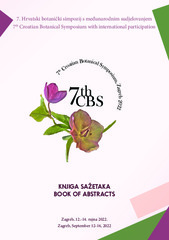| dc.creator | Zbiljić, Miloš | |
| dc.creator | Lakušić, Branislava | |
| dc.creator | Kuzmanović, Nevena | |
| dc.creator | Stojanović, Danilo | |
| dc.creator | Lakušić, Dmitar | |
| dc.date.accessioned | 2023-10-24T12:37:02Z | |
| dc.date.available | 2023-10-24T12:37:02Z | |
| dc.date.issued | 2022 | |
| dc.identifier.isbn | 978-953-8097-03-4 | |
| dc.identifier.uri | https://farfar.pharmacy.bg.ac.rs/handle/123456789/5147 | |
| dc.description.abstract | Teucrium montanum L. is a semi-woody evergreen small shrub distributed in southern and central Europe, Asia Minor, and Algeria in North Africa. The species has a very wide ecological valence occurring in various Mediterranean, sub-Mediterranean, continental as well as oro-Mediterranean and Alpine habitats. Due to its wide ecological valence and broad distribution, T. montanum displays high morphological variability, which is reflected in a large number of described taxa associated with it. In Europe, about thirty taxa have been described at specific and infraspecific levels, of which only T. montanum subsp. montanum and T. montanum subsp. helianthemoides (Adamović) Baden are accepted, while all the others are considered synonyms of T. montanum. The observed morphological diversity is reflected in the presence of six taxa described from the Balkan Peninsula: T. montanum subsp. helianthemoides, T. montanum var. hirsutum Boiss., T. montanum var. modestum Heldr., T. montanum var. parnassicum Čelak., T. pannonicum A. Kern., and T. skorpili Velen. During field research throughout the Balkans, seven morphologically more or less well-defined groups with relatively solid geographical differentiation were observed. Five of the seven groups fit the already described infraspecific taxa, while two groups are morphologically specific but do not correspond to the existing taxa. The aim of this study was to describe the overall morpho-anatomical variability of T. montanum sensu lato in the Balkans and to determine whether the seven identified groups can be distinguished based on morpho-anatomical characters. The most typical populations of these groups could be separated quite well based on the quantitative morphological traits. Multivariate analysis of all samples showed a solid separation of three groups and a significant number of individuals with intermediate positions. Other groups did not show statistical diversification but possess a specific combination of morphological characters by which they can be identified. | sr |
| dc.language.iso | en | sr |
| dc.publisher | Hrvatsko botaničko društvo (Croatian Botanical Society) | sr |
| dc.relation | info:eu-repo/grantAgreement/ScienceFundRS/Ideje/7750112/RS// | sr |
| dc.rights | openAccess | sr |
| dc.source | 7th Croatian Botanical Symposium with international participation, Zagreb 2022 - Book of Abstracts | sr |
| dc.subject | Teucrium | sr |
| dc.subject | Teucrium montanum | sr |
| dc.subject | Balkan | sr |
| dc.title | Morphological diversification of Teucrium montanum L. sensu lato on the Balkan Peninsula | sr |
| dc.type | conferenceObject | sr |
| dc.rights.license | ARR | sr |
| dc.citation.spage | 33 | |
| dc.citation.epage | 33 | |
| dc.description.other | Usmeno izlaganje na skupu 7th Croatian Botanical Symposium with international participation (7. Hrvatski botanički simpozij s međunarodnim sudjelovanjem), Zagreb, September 12-14, 2022. | sr |
| dc.identifier.fulltext | http://farfar.pharmacy.bg.ac.rs/bitstream/id/14215/Morphological_diversification_of_pub_2022.pdf | |
| dc.identifier.rcub | https://hdl.handle.net/21.15107/rcub_farfar_5147 | |
| dc.type.version | publishedVersion | sr |

